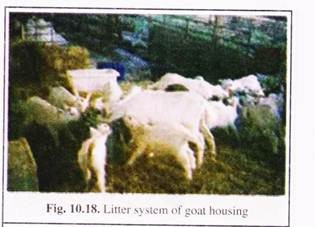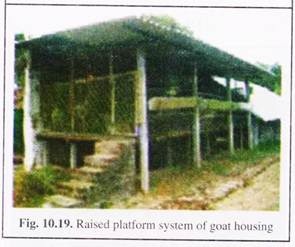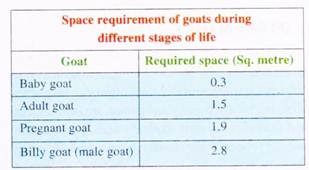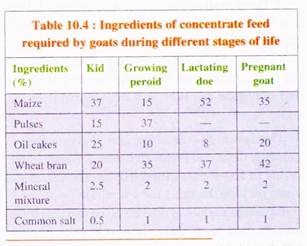The following points highlight the ten main aspects for managing a goat farm. The aspects are: 1. Housing of Goats 2. Selection of Goat Breeding Stock 3. Feeding Management 4. Breeding Management 5. Care of Goats during Pregnancy 6. Care of Kids 7. Routine Operations in Goat Farm 8. Marketing.
Aspect # 1. Housing of Goats:
Goats do not like being closely confined and thus, do not need any special housing.
However, in goat farm under commercial conditions, goat should be housed properly with the following general tips:
(i) Goat house/shed must be strong and comfortable with enough space for taking rest of goat.
ADVERTISEMENTS:
(ii) It should be made in dry weather and environment.
(iii) The floor of the house must have to keep always dry.
(iv) Plenty of light and air should be available in the house.
(v) There must be system for controlling temperature and moisture.
ADVERTISEMENTS:
(vi) The house should be kept free from being damping. Because damping condition is responsible for various diseases.
(vii) Never let the rain water to enter inside the house.
(viii) Goats are feared about cold and water. So extra care should be taken in rainy and winter seasons. Otherwise, they may caught by pneumonia.
(ix) The place must have the facilities of cleaning well regularly.
ADVERTISEMENTS:
(x) If possible the wall of the house should be made with concrete or bamboo poles.
Types of Goat House:
There are no definite designs of goat house or sheds and many types of houses for goat-rearing are found in India.
However, following types of goat houses are most common:
(a) Goat Housing Over Ground (Litter System):
Generally these types of house are made over the ground. This is the most common house for goat. Farmers make the floor of this house with brick and cement or simply with soil and spread some dry straw, paddy husk, groundnut-shell over the floor to make a thin litter (Fig. 10.18).
But this should be periodically turned to remove the foul smell. This type of house must have to keep always dry and clean to reduce external parasitic infestation.
(b) Goat Housing Over Pole (Raised Platform System):
ADVERTISEMENTS:
These types of house are made over pole. The floor of the house is about 1 to 1.5 metres high (3.5 to 5 feet) from the ground. These types of house keep the goat free from damping condition, flood water, etc.
The poles and floor are generally made with bamboo or wood (Fig. 10.19). These types of house are very suitable for goat farming because it is very easy to clean. Wastes and urine of goat can easily be removed from the house. Diseases are also less in this housing system.
(c) Concrete House:
These types of goat-houses are fully made with concrete. Concrete houses have many advantages. It is very easy to clean and always keep the goat safe from all types of enemies. The house may be built over ground or concrete poles. Both types are easily maintained. Diseases are less in this housing system. But it is very expensive method of goat housing.
Required Space for Goat:
In accordance with increasing body size and weight of goat, they need more space. A house of 1.8 metre x 1.8 metre x 2.5 metre (5.5 feet x 5.5 feet x 8.5 feet) is suitable for staying of 10 small goats. The space can be extended or decreased according to the number of goats present in the farm.
In general, the required space for proper growing of goats during different stages of life is mentioned below:
Aspect # 2. Selection of Goat Breeding Stock:
Goats in good health and having good physical features must be purchased in consultation with veterinarian or bank’s technical officer. Animals which are ready to breed and in prime stage of reproduction are generally preferred. Newly purchased goats are kept under observation for about 15 days and then mixed with the general flock.
Aspect # 3. Feeding Management:
Within or near the goat farmhouse, there must be bushes or shrubs for browsing of animals. Stall-fed goats are efficient converters of farm and crop residues into excellent organic manure.
Goats relish the stalks and residues of most of the nutritious cereals and they do well particularly when mixed with green fodder such as grasses and subabul. So, stall feeding for goats are ideal for intensive integrated farming system (IIFS).
Otherwise, as an alternative to above, supply of cultivated fodder from own farm or from surrounding farms may be ensured. As a general rule, most of the energy requirements of goats should be met through roughages.
Half of the roughages should be leguminous green fodders and rest half should be grasses or tender tree leaves. In the absence of good quality green fodders, concentrates must be considered to replace them.
Kids should be fed colostrums (see below) up to 5 days of age. Later on, they can be put on kid starter rations. Green leguminous fodders should be offered sufficiently to kids from 15 days onwards. Salt and water should be provided to kids at all times.
During breeding season, additional concentrates should be given to bucks and does. Concentrate feed can be prepared by mixing the ingredient in proper ratio as mentioned in Table 10.4.
Aspect # 4. Breeding Management:
In general, it is planned to obtain 3 kidding’s in 2 years by adopting optimal breeding management. So, for about 25 does (female goat), one buck (male goat) should be provided in one breeding season.
In goat farms, there are 3 systems for breeding, which are as follows:
i. Pasture or Pen Breeding:
It occurs in normal course in the herd. This type of breeding system, thus involves very little labour and results in a large percentage of does conceiving. It also has the following disadvantages. No control over when the does are bred and when they kid. Young kids below 5 months of age are also chased by bucks.
ii. Artificial Insemination:
In this system, frozen semen is thawed and deposited into the reproductive tract of the doe by a trained technician using a plastic inseminating pipette. This system is gaining popularity and will continue to do so as long as suppliers continue to offer a selection of goat semen.
iii. Hand Mating:
In this system, the buck is kept in a lot of his place and is never allowed to run with the does. As the does come into heat, they are taken to his pen, either singly or two or three at a time, and the buck breeds them there, the breeding is observed and as the doe is bred, she is removed from the pen.
This system has the advantages of giving precise breeding dates and it can give does a considerable period of rest if the farmers like so. The disadvantages include the need for a separate buck shed, considerable amount of time involved and unless the farmers have many does, the cost of buck per doe becomes high.
iv. Cross-Breeding:
When unrelated goats are mated, the system is known as cross-breeding. First cross-progeny is usually superior to their parents. This is known as hybrid vigour. Cross-breeding is used to improve the productivity of local animals. Using an exotic buck to breed a native doe will produce strong vigorous offspring. These offspring will have increased production potential.
Under tropical conditions, cross-breeding should be considered successful, if the off-springs are sufficiently better than the native female stock. Indian breeds of goat exhibit considerable variation in lactation milk yields, but in general, average about ½ to 1 kg/day.
The lactation milk yields are, however, low when compared to milk yields of about 3 to 5 kg/day of goat breeds in a temperate environment. These differences are mainly due to breed, plan of nutrition, size, age and management methods.
Crossbreeding of local breeds with improved exotic breeds has brought about considerable improvement in milk production with enough capacity to withstand the direct and indirect effects of a hot climate.
Aspect # 5. Care of Goats during Pregnancy:
In advanced stage of pregnancy, the does must be transferred to either kidding pens or separately marked space for kidding within the main shed after thoroughly disinfecting it. After kidding, the does should be provided with warm bran mash for two days.
Aspect # 6. Care of Kids:
Immediately after parturition, the naval cord will be disinfected with tincture of iodine as soon as it is cut with a sharp knife. Almost immediately after birth, the kids, if healthy and strong, are on their legs and start sucking their mother’s teats.
If more than one kid is born, it may be necessary especially when they are very young, to ensure that the smallest of them gets its due share of milk, because it may be prevented from doing so by the stronger kids. The kids should be protected from extreme weather conditions, particularly during the first two months.
For the first 3 to 4 days after birth, the kids must be given colostrum. The rearing of kids may be done either natural or by hand rearing and each has its advantages and disadvantages. In India, it is the natural method that is usually practised and this consists of in leaving the kid to take what amount of milk it can obtain from its mother.
Hand rearing is resorted to when weaning is practised or when the goat dies. There are two methods of hand rearing, one consisting of feeding the kid with a bottle and the other is feeding it off the pail.
Both methods are learned by them easily, but bottle feeding is to be preferred because the saliva that is produced during the process of suckling the milk, aids in digestion. Kids will also readily take to feeding on a foster mother when they are put on her teats.
When about two weeks old, kids begin to nibble green food or dry fodder and it would be well to see that small quantities of these are within their easy reach at this lime. It is also important that kids are allowed plenty of open air and sunlight.
In hot weather, it is best to keep them in an enclosure build round a tree so that they may also be provided with shade. The enclosure should be large enough to allow them plenty of exercise.
At the age of 2 to 3 months, the suckling may be practically discontinued and at four months the kids should be completely weaned because by this time they will become fit, like the older goats, to eat solid food, although they may as well be allowed to suckle a little longer.
Male kids, unless they are required for breeding purposes should be kept separated from the female kids.
At one year, a buck should receive 1.8 kg of grain mixture, the allowance being increased by 50 per cent during the breeding season. A liberal amount of fodder should be given. An average of 7 to 8 kg of green fodder per day should be adequate for a full grown Jamunapari buck, when entirely stall fed. Where the animal is unduly fat, its grain ration should be cut.
Aspect # 7. Routine Operations in Goat Farm:
(i) Castration:
Castration of bucks, if required, should be done at the age of 2 to 4 weeks, although castration at later stage also becomes successful.
It is usually done to:
(i) Increase the palatability of meat,
(ii) Increase the body weight rapidly, and
(iii) Make the skin superior in quality.
Following castration, there may be swelling in the place of testis which will be treated with medicines at least for 2-4 days.
(ii) Dehorning:
Dehorning is the cutting off horns that have already grown to significant size, and disbudding is the removal of horn buds at an early age to prevent further horn-growth. In goat farms if these two methods are practised, that should be done very carefully under medical persons. These practices are done just to avoid fighting amongst the horned stocks and to keep the horned and polled animals together.
(iii) Care of Feet:
Farm goats often suffer from a condition, known as overgrown feet, where deformity in feet can cause extreme discomfort, even arthritis in old age. It can be avoided by pairing the hooves when feet are overgrown.
(iv) Marking of Goats:
Goats in flock or herd can be easily identified if they are marked. Marking can be done by 3 ways, e.g., ear-tattooing, ear-tagging and ear-notching. These should be carried out carefully within one week after kidding carefully.
(v) Tethering:
Tethering is not an option for keeping goats. There are dangers that tethered goats might become tangled/strangled and they cannot escape from bad weather/dogs/children, etc. However, if only one or two goats are raised, tethering can be used.
According to Animal Welfare Act, 1999, a tethered goat must be provided with adequate feed, water and shelter.
Following points to be noted while:
(a) Goats must be accustomed to being tethered and used to traffic if grazing the roadside,
(b) A leather collar should be used around the goats neck to which a light chain is attached,
(c) There may be one swivel at both ends of the tether,
(d) The goat must be given opportunity to forage in a wide area with vegetation.
(e) The foraging area to be changed regularly.
(vi) Exercise Paddock for Stall Fed Goats:
Goats when reared in stall fed system it is of utmost importance to provide the exercise paddock.
Aspect # 8. Marketing:
The marketable products of goat farming include the fattened kids, manure, culled animals. Marketing avenues for the above products are slaughter houses, individual meat consuming customers and agriculture farms.
Therefore, availability of either slaughtering facilities or traders who will purchase live animals should be ensured to convert the fatteners into wholesome meat and meat products. Further, demand for manure from nearby agriculture farms must also be ensured.



